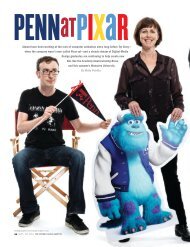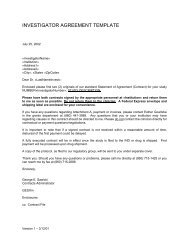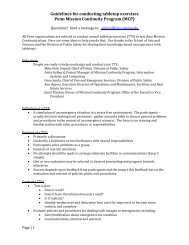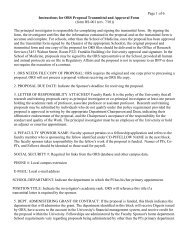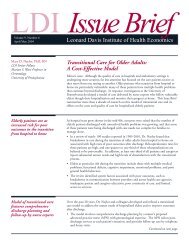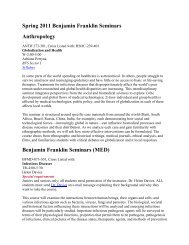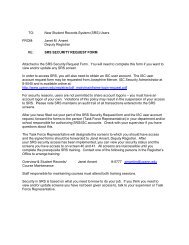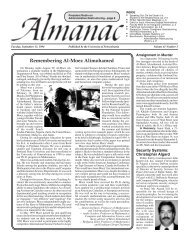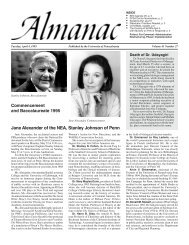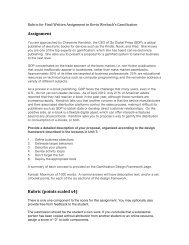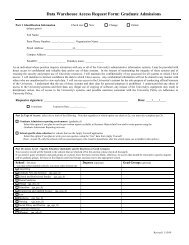Benjamin Franklin Scholars Seminar fnar 238/538 â401 ...
Benjamin Franklin Scholars Seminar fnar 238/538 â401 ...
Benjamin Franklin Scholars Seminar fnar 238/538 â401 ...
Create successful ePaper yourself
Turn your PDF publications into a flip-book with our unique Google optimized e-Paper software.
o p e n b o o k : a v i s u a l e x p l o r a t i o n<br />
<strong>Benjamin</strong> <strong>Franklin</strong> <strong>Scholars</strong> <strong>Seminar</strong><br />
<strong>fnar</strong> <strong>238</strong>/<strong>538</strong> –401<br />
Wednesdays, 4:30 pm – 7:30 pm<br />
Fisher Art Library, Davis <strong>Seminar</strong> Room<br />
Sharka Hyland, Instructor (sharka@design.upenn.edu)<br />
c o u r s e o b j e c t i v e s<br />
The goal of the course is to explore the visual aspect of the thinking process—how visual representation<br />
structures your thoughts about the information it represents.<br />
You will choose a topic, and then you will both write and make a book.<br />
f o r m a t<br />
weekly seminars<br />
The course will be conducted in a seminar format, emphasizing discussion and critical thinking<br />
about a wide range of conceptual and formal issues.<br />
The projects naturally are diverse, ranging from personal histories to scholarly investigations.<br />
You will see how your fellow students approach a problem. Throughout the semester, we will also<br />
have visiting critics.<br />
research<br />
In the first weeks of classes, we will have an overview of the resources available to you at Penn,<br />
in particular the research tools—both traditional and digital—offered by the Penn library system.<br />
You will learn to use the web search engines for a focused inquiry, and how to find high quality<br />
images for your project.<br />
workshops<br />
Since you will be making a material object—a book —as an integral part of your investigation, we<br />
will also have a series of informal workshops, about crafts related to book arts. The topics will<br />
include methods of text/image production, ranging from computers to letterpress to collage. We<br />
will also explore principles of book design and typography and place them in historical context.<br />
There will also be a workshop surveying forms of bookbinding, from traditional to experimental.<br />
Some of these workshops will be scheduled during the regular class time; however, because of the<br />
time limitations and the availability of some facilities (the letterpress room, the computer lab,<br />
etc.), we will also have to meet at additional times.<br />
By the end of the course, you will produce a book, which can range in format from a traditionally<br />
designed and bound book to a one-of-a-kind experimental form with foldouts and cutouts.
Open Book, page 2<br />
p r e r e q u i s i t e s , e x p e c t a t i o n s , r e q u i r e m e n t s<br />
There are no prerequisites for this course.<br />
The class is intended for students who are strongly motivated to pursue a particular interest,<br />
and who can work independently—that means with plenty of feedback and support but little<br />
supervision.<br />
Because most of the work will be done outside of class, you will be expected to self-direct your<br />
work, both in terms of adhering to a (self-imposed) time schedule and in taking the initiative to<br />
find the resources you need.<br />
The freedom you will have in shaping your project might present difficulties different from a<br />
traditional classroom assignment. You will be engaged in a creative process which is, by nature,<br />
an open-ended endeavor; it comes with surprises and challenges.<br />
weekly presentations of work-in-progress<br />
Every Wednesday, we will discuss your project in class. You will present the progress you have<br />
made and receive feedback.<br />
From the very beginning, we will focus on articulating information visually, on keeping material<br />
records of one’s thinking process, on actually creating these records in cases in which we would<br />
normally forego the visual and rely on a (written or mental) note. You should get into the habit<br />
of drawing diagrams, visualizing abstract relationships, writing down ‘irrelevant’ thoughts, collecting<br />
seemingly unrelated artefacts and clippings, taking photographs, and collaging. In short,<br />
you should allow yourself to explore without the constant corrective of what is ‘relevant’ to your<br />
project. These visual records (preferably in the form of a bound sketchbook) will be part of your<br />
weekly presentation and should help you to convey your ideas more clearly.<br />
As we explore different media — computers, drawing, photography, letterpress, paper crafts, collage,<br />
typewriter, etc.— you will be expected to experiment with the newly acquired skills by applying<br />
them to in-progress models of your project. This might be a single letterpressed sheet, a digitally<br />
printed double-page spread of text and images, a paper dummy of an experimental binding<br />
method, etc.<br />
peer editing and feedback<br />
Students will be expected to engage with each other’s projects. This will involve—in addition to<br />
in-class discussions—reading fellow students’ work-in-progress and making editing suggestions.<br />
student slide presentations<br />
We will discuss traditional and alternative book forms and look at examples of book-related<br />
arts. During the semester, each student will be asked to make a 10–15 minute presentation<br />
accompanied by images (slides, powerpoint, etc.) on assigned topics. The presentation should<br />
include outline handouts.
Open Book, page 3<br />
readings; response papers<br />
Occasionally, short readings will be assigned, either to the whole class, or individually. You will be<br />
asked to write informal responses to these readings. These responses will be due by the Sunday<br />
following the assignment.<br />
creative writing resources<br />
The Penn Critical Writing Program offers writing tutorials and other types of writing assistance.<br />
You are strongly encouraged to meet with a tutor to discuss your work.<br />
r e v i e w s , g r a d i n g , a t t e n d a n c e<br />
In addition to the ongoing informal in-class critiques, there will be a mid-term review with<br />
invited faculty. The finished project will be presented during a formal final review at the end of<br />
the semester.<br />
grading scheme<br />
About 40% of your final grade will be based on class participation (your weekly progress<br />
presentations and discussion). 60% will be derived from the grades you receive during the semester<br />
(mid-term review, slide presentation, response papers, final book).<br />
attendance<br />
If you miss more than two classes, each additional absence will lower your grade by one full letter.<br />
Please refer to departmental policies on attendance.<br />
If you have to miss a class (for whatever reason), you will need to contact the instructor as soon as possible<br />
and obtain any assignments to be completed for the next class. Please remember that it is your responsibility<br />
to stay on schedule with the rest of the class.<br />
d i g i t a l l a b s , p o l i c i e s<br />
There are several computer labs available to you (Van Pelt Library – Vitale Digital Media Lab at<br />
the Weigle Information Commons; Rosengarten Computer Lab). Please check on hours, access,<br />
equipment and compatibility of software. (www.library.upenn.edu/computing/laptops_labs.html )<br />
We will have a couple of tutorials covering the basics of digital imaging. Those of you who have no<br />
or litle background in digital imaging (Photoshop, InDesign) will be required to attend additional<br />
scheduled tutorials.<br />
internet, earphones, cellphones<br />
Internet use and text-messaging during class time is not allowed (unless specifically permitted by<br />
the instructor). Any communication devices, such as cellphones, must be switched off and hidden out<br />
of sight.
Open Book, page 4<br />
back-up of files<br />
Each student has data storage space reserved on the server. This space is accessible only with your<br />
password. In addition, it’s recommended that you back-up all your work after every class on a<br />
portable data storage device.<br />
email communication<br />
– You are responsible for checking your email regularly for updates and course materials.<br />
– Remember that you cannot automatically reply to messages sent through the classlist server.<br />
Always email to the instructor’s individual address (see page 1 of this syllabus).<br />
– Also, please always put “OB” in the subject field.
Open Book, page 5<br />
r e c o m m e n d e d r e a d i n g<br />
Aitken, Doug<br />
The broken screen: 26 conversations with Doug<br />
Aitken: expanding the image, breaking the<br />
narrative / edited by Noel Daniel<br />
New York: Distributed Art Publishers, 2005<br />
Christie, Manson & Woods International Inc.<br />
The history of the book : the Cornelius J. Hauck<br />
Collection<br />
New York, N.Y. : Christie’s, 2006<br />
Rare Bk & Ms Library Reference<br />
Z999 .C45 2006<br />
Deleuze, Gilles and Guattari, Felix<br />
A Thousand Plateaus<br />
University of Minnesota Press, 1987<br />
Doczi, György<br />
The power of limits: proportional harmonies<br />
in nature,art and architecture<br />
Shambhala Publications, 1981<br />
Drucker, Johanna<br />
The Century of Artists’ Books<br />
New York City: Granary Books, 2004<br />
Drucker, Johanna<br />
Figuring the Word: Essays on Books, Writing,<br />
and Visual Poetics<br />
New York: Granary Books, 1998<br />
Harmon, Katharine<br />
You Are Here: Personal Geographies and<br />
Other Maps of the Imagination<br />
Princeton Architectural Press, 2004<br />
Steven Heller, ed.<br />
The education of a comics artist: visual narrative<br />
in cartoons, graphic novels, and beyond<br />
New York: Allworth Press, 2005<br />
course reserve<br />
Heller, Steven and Mirko Ilic<br />
The anatomy of design: uncovering the influences<br />
and inspirations in modern graphic design<br />
Gloucester, Mass.: Rockport, 2007<br />
R. Klanten, M. Hübner, eds.<br />
Fully Booked: Cover Art and Design for Books<br />
Gestalten Verlag, 2008<br />
Lauf, Cornelia and Phillpot, Clive, eds.<br />
Artist / Author: Contemporary Artists’ Books<br />
Distributed Art Publishers Inc., 1998<br />
Lupton, Ellen<br />
Graphic design: the new basics<br />
Princeton Architectural Press, 2008.<br />
Lyons, Joan, ed.<br />
Artists’ Books: A Critical Anthology and Sourcebook<br />
Giggs M. Smith, Inc., 1985<br />
Rothenberg, Jerome and Clay, Steven, eds.<br />
A Book of the Book: Some Works & Projections<br />
About the Book & Writing<br />
New York: Granary Books, 2000<br />
Smith, Keith A.<br />
Structure of the Visual Book<br />
Keith Smith Books, Book Nr. 95, 1984<br />
Smith, Keith A.<br />
Non-Adhesive Binding<br />
Keith Smith Books, Book Nr. 128, 1991<br />
Tufte, Edward R.<br />
Beautiful Evidence<br />
Cheshire, Conn.: Graphics Press, 2006<br />
Turchi, Peter<br />
Maps of the Imagination: The Writer as<br />
Cartographer<br />
San Antonio: Trinity University Press, 2004<br />
A selection of books will be put on course reserve at the Art Library desk.<br />
additional reading<br />
Additional texts will be assigned based on individual projects.
Open Book, page 6<br />
fall 2008<br />
schedule<br />
s e m e s t e r o u t l i n e<br />
Please check your email regularly for changes and announcements.<br />
9/3 <br />
Course introduction, overview of facilities and resources.<br />
We will introduce and discuss your individual projects.<br />
A first draft of your proposal will be due by the weekend (9/7).<br />
9/10 <br />
Class discussion of individual projects<br />
Modify and/or refine your proposal as needed.<br />
A second draft of the proposal will be due by the weekend (9/14).<br />
Workshops/presentations (in class, or time tbd): digital labs; design and imaging software<br />
9/17 – 10/8 <br />
Class discussion of individual projects<br />
Compilation and presentation of visual material; exploring multiple methods of generating type<br />
and images. Articulation of the formal structure of your book.<br />
Student slide presentations<br />
Workshops/presentations (in class, or time tbd): research tools, internet resources,<br />
printshop, letterpress<br />
Rare Book Collection visit (in class, or time tbd): artists books<br />
10/15 <br />
Midterm: first formal critique (visiting faculty)<br />
You will present a work-in-progress model of your book and discuss your project’s concept.<br />
You will write a brief summary of the feedback you received.<br />
You will also respond and suggest how to resolve the issues raised. The response is due by 10/19.<br />
10/22 – 11/12 <br />
Class discussion of individual projects<br />
Student slide presentations<br />
Workshops/presentations (in class, or time tbd): bookbinding methods<br />
Wednesday, 10/22, 6pm – ICA Whenever Wednesday Tour: R. Crumb
Open Book, page 7<br />
11/19 <br />
Second formal critique (visiting faculty)<br />
You will present a near-final version of your book and discuss your progress to-date.<br />
As before, you will write a brief summary of the feedback and respond to suggestions.<br />
Your response is due by 11/23.<br />
12/3 <br />
Last class; discussion of individual projects<br />
Early December, date and time tbd<br />
Final presentation of your book
Open Book, page 8<br />
r e c o m m e n d e d s u p p l i e s<br />
USB portable flash drive<br />
cutting mat, 12 x 18 or larger<br />
X-Acto knife, replacement blades<br />
metal ruler with non-slip backing, 24 inches<br />
bone folder<br />
Bainbridge Studio Tac adhesive<br />
additional costs<br />
Your other expenses will include printing charges, as well as paper and binding supplies.<br />
art supplies retailers<br />
Utrecht (21st and Chestnut; Broad and Spruce)<br />
Dick Blick (13th and Chestnut)<br />
Artist’s Supply (3rd and Market)<br />
Pearl (5th and South)<br />
jerrysartarama.com
Open Book, page 9<br />
fall 2008<br />
schedule<br />
l e c t u r e s a n d e v e n t s<br />
Wednesday, 10/22, 6pm<br />
ICA: Whenever Wednesday: Tour: R. Crumb Associate Curator Jenelle Porter sorts through the<br />
themes and ideologies critical to Crumb’s work—social satire, sex, blues and jazz, mind-altering<br />
substances, autobiography—and traces the development of his ultimate achievement and most<br />
important legacy: a wide-ranging, if critically suspicious, humanity.<br />
Wednesday, 10/29, 7 pm<br />
ICA: Whenever Wednesday: Conversation with ICA Ramp Project artist Odili Donald Odita about<br />
nonrepresentational art and its manifestation as a form within a global context in the twenty-first<br />
century.<br />
Thursday, 11/6, 7:30 pm<br />
Free Library: Graphic Novels Panel: Art Spiegelman, Chip Kidd, Jessica Abel, Charles Burns &<br />
David Heatley<br />
Wednesday, 12/3, 7 pm<br />
ICA: Whenever Wednesday: Lecture: Douglas Blau,Renowned New York artist, critic, and curator<br />
Douglas Blau will discuss his sprawling new picture epic on view at ICA, as well as his landmark<br />
installations, writings, and exhibitions from the past three decades.
Open Book / Appendix<br />
Book as a metaphor and an object<br />
When we speak of a book, we usually refer to a text; the formal and material qualities of the container<br />
are usually considered secondary to its content. The form of a well-designed book tends to<br />
‘disappear’ and to become transparent — form follows (is determined by) function.<br />
In some instances, we do think of books as objects – artist’s books (often one-of-a-kind, handmade<br />
volumes), coffee table books, novelties sold at the bookstore’s checkout, ‘design-manifesto’<br />
type books, bibliophilia.<br />
We take it for granted that, in any case, the ‘text’ is finished before the ‘object’ takes form. The<br />
form follows (comes after) function.<br />
Let’s consider an alternative approach: let’s make the book as we write it; let’s remain open to<br />
the possibility that the form, the bookness, may inform the content.<br />
Bookness<br />
The book, as a physical object, is the source of many metaphorical uses. An ‘open book’ is one of<br />
the most well known. But what are the defining attributes of the material fact that the metaphor<br />
appropriates — what is the ‘bookness’ of a book? What does its being ‘open’ imply?<br />
For the purpose of this class, we will paraphrase Philip Smith’s definition of what constitutes<br />
bookness: an object of multiple planes carrying visual/verbal content, self-contained in its<br />
meaning as well as in an actual physical sense:<br />
Bookness – in its simplest meaning the term covers the packaging of multiple planes held together<br />
in fixed or variable sequence by some kind of hinging mechanism, support, or container, associated<br />
with a visual/verbal content called a text. The term should not strictly speaking include precodex<br />
carriers of text such as the scroll or the clay tablet, in fact nothing on a single leaf or planar<br />
surface such as a screen, poster or hand-bill. (...)<br />
A text is a text and not a book, but any other object one likes to imagine may perhaps be its conveyance.<br />
A text can be inscribed on anything but this does not make it a book, or have the quality<br />
of bookness. The book is not the text, although it is traditionally associated with it, and these<br />
two elements appear often to be mistaken for the same thing. The book is the hinged multiplanar<br />
vehicle or substrate on which texts, verbal, or tactile maybe written, drawn, reproduced, printed or<br />
assembled.(...)<br />
The planes of a book have a necessary relationship or they simply become a collection of arbitrary<br />
planes for which a book format is not essential for the conveyed meaning.<br />
Philip Smith (palimpsest.stanford.edu/1996)



